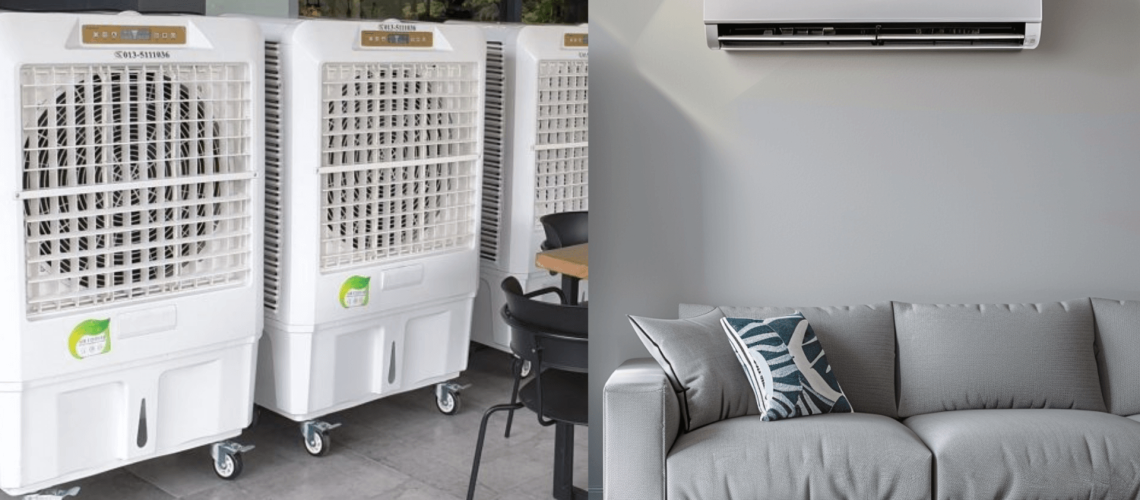For those living in hot weather, staying cool and comfortable is a must. But when it comes to choosing a cooling system for your home, the options can be tricky. These options are mainly evaporative air coolers and air conditioning systems. Both offer relief from the heat, but they function in very different ways.
Understanding these differences will help you select the perfect cooling solution for your needs and climate.
Differences Between an Evaporative Air Cooler and Air Conditioner
Evaporative air coolers, sometimes called swamp coolers, utilize a natural process called evaporative cooling. Water is passed through a pad, and a fan blows air through the moistened pad. As the water evaporates, it absorbs heat from the air, creating a cool and refreshing breeze. Air conditioners, on the other hand, employ a refrigerant cycle.
Warm air is drawn into the unit, where a refrigerant absorbs heat and changes state from a liquid to a gas. The hot gas is then compressed, further raising its temperature, before being released outside. The cooled refrigerant then absorbs heat from the indoor air, completing the cycle.
1. Costs
Upfront Costs
Evaporative air coolers, particularly portable models, are significantly cheaper than air conditioning systems. Installation for a whole-house evaporative cooler can be more involved, but it still generally costs less than installing a central air conditioning system.
Running Costs
Evaporative coolers are much more energy-efficient than air conditioners. They primarily use electricity to power the fan and water pump, while air conditioners require significantly more energy to run the compressor and other components. In Malaysia’s climate, where evaporative cooling can be very effective, the running costs can be a major advantage.
Installation
Portable evaporative coolers require no installation – simply fill the water tank, plug it in, and enjoy the cool air. Whole-house evaporative coolers require ductwork installation, similar to some central air conditioning systems. However, the ductwork for evaporative coolers is typically simpler and less expensive.
2. Cooling (and Heating) Capabilities
Cooling Power
Air conditioners offer more precise and powerful cooling. They can significantly lower indoor temperatures and maintain a consistent coolness regardless of outdoor conditions. Evaporative coolers are most effective in dry climates. In Malaysia’s humid environment, their effectiveness can be reduced. However, they can still provide a refreshing cool breeze, particularly in well-ventilated spaces.
Heating
Neither evaporative coolers nor standard air conditioners provide heating capabilities. However, some air conditioners offer a heat pump function that can reverse the cooling cycle to provide heat in colder months.
So, which cooling solution do you choose?
The ideal cooling solution depends on a combination of factors, including your priorities, climate, and budget. Here’s a breakdown to help you make the decision:
1. Cost-conscious Malaysians
If affordability is a top concern, and you reside in a drier region of Malaysia, evaporative air coolers are a compelling choice. They offer a cost-effective way to achieve a noticeable cooling effect, especially during the hotter months.
With minimal running costs compared to air conditioners, evaporative coolers can translate to significant savings on your electricity bill. Look for evaporative air cooler options in Malaysia to find models specifically designed for the Malaysian climate.
2. Precise Cooling Needs
If you prioritize powerful and precise cooling control regardless of the climate, air conditioners are the way to go. They are great at significantly lowering indoor temperatures and maintaining a consistent coolness, even on the hottest days.
This can be particularly beneficial in humid regions like Malaysia, where evaporative coolers might struggle. However, be prepared for a higher initial investment for purchasing and installing the system, along with potentially higher running costs due to their increased energy consumption.
3. Considering Additional Factors
Beyond cost and climate, there are other factors to consider:
Home Size and Layout
For extensive living spaces, central air conditioning systems might be necessary to ensure consistent cooling throughout the entire home. Evaporative coolers, while effective in smaller spaces, might struggle to cool larger areas efficiently.
Ventilation
Evaporative coolers work best in well-ventilated spaces. If your home has limited airflow, an air conditioner might be a better option.
Noise Level
Both systems generate noise. Air conditioners tend to be quieter, particularly newer models. Portable evaporative coolers can be noisier, while whole-house models might have variable noise levels depending on the fan speed.
Environmental Impact
If eco-friendliness is a priority, evaporative coolers are the clear winner. They use significantly less energy than air conditioners, reducing your carbon footprint.
Final Takeaways
All in all, to make the best decision, the best approach is to consider all these factors. Research both evaporative air cooler and air conditioner options in Malaysia to find models that fit your needs and budget.
If you are unsure, consulting with a reliable, qualified HVAC professional can be extremely helpful. They can assess your specific situation and recommend the most suitable cooling solution for your home.


